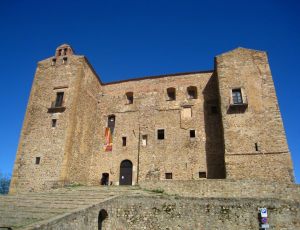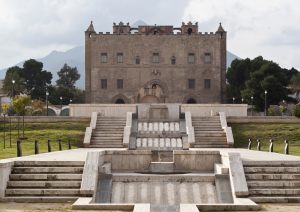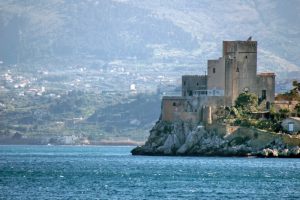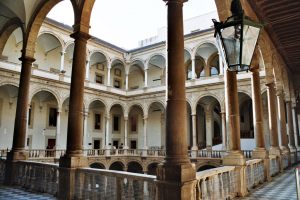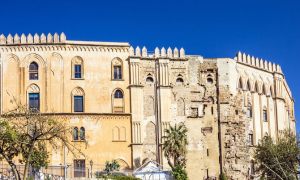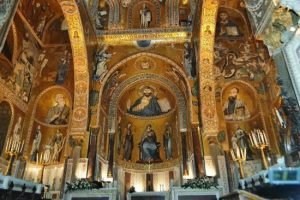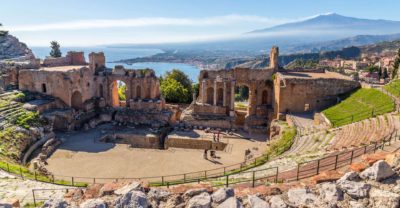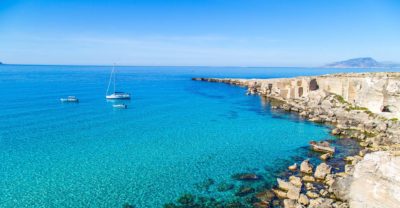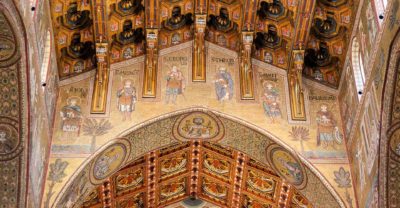Towers and Castles
Palermo
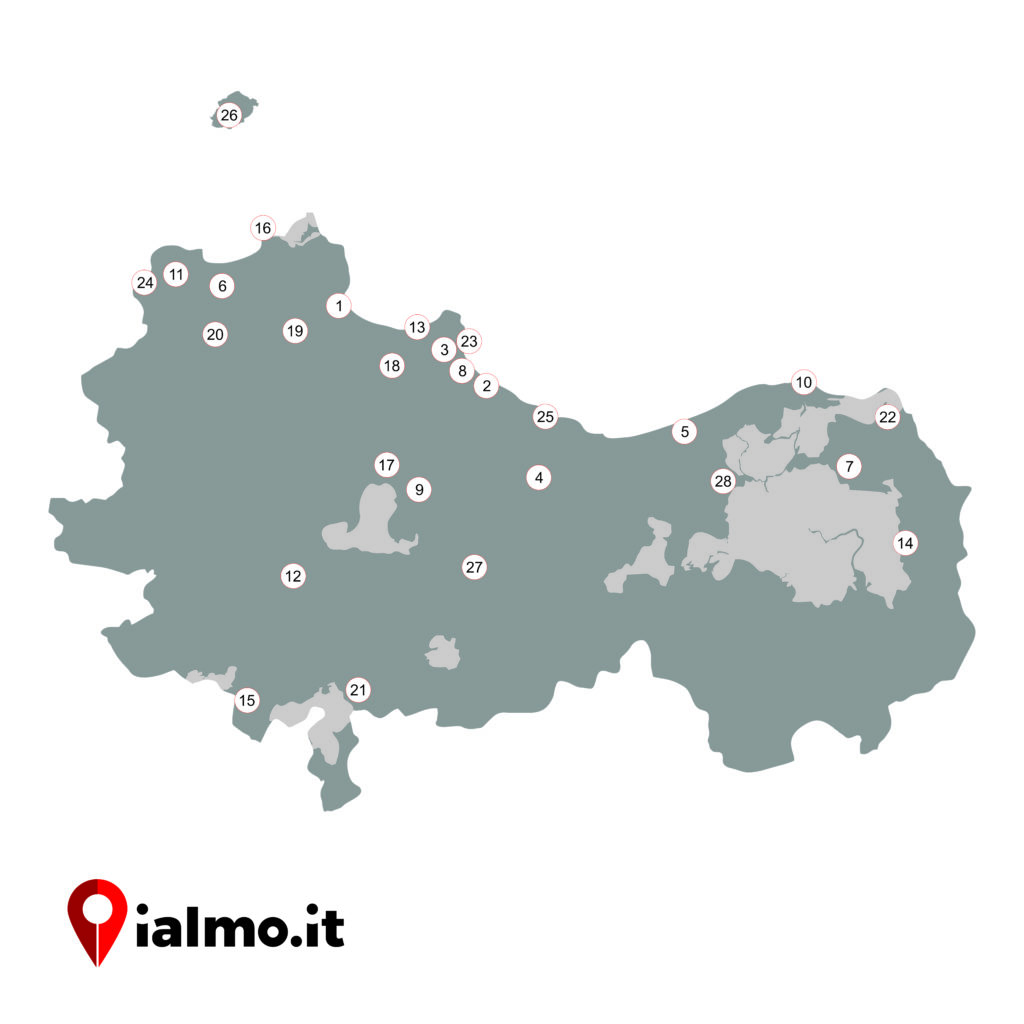
Palazzo dei Normanni, Palermo: also known as Palazzo Reale, is currently the seat of the Sicilian Regional Assembly. It is one of the most visited monuments on the island. From 3 July 2015 it is part of the World Heritage (Unesco) within the serial site “Palermo Arab-Norman and the cathedrals of Cefalù and Monreale”. The imposing Palace, rich in decorations, is the oldest royal residence in Europe, home of the sovereigns of the Kingdom of Sicily, imperial seat with Frederick II and Corrado IV and the historic Sicilian Parliament. It encompasses the foundations, stratifications of the first fortified settlements of Phoenician-Punic origin dating from the 8th and 5th centuries BC and, according to some witnesses, the building would have risen on the remains of an Arab fortress restored by Roger II.
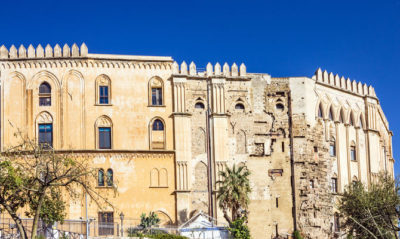 In 1132 Roger II of Sicily built the middle part of the building, the Palatine Chapel (Basilica with three naves) and the Joharia Tower. The place of worship dedicated to St. Peter the Apostle supplanted the primitive mosque built on the prisons and dungeons of the palace. The dome, the walls of the transept and the apses are entirely decorated in the upper part by Byzantine mosaics, among the most important in Sicily, depicting the Christ Pantocrator, the evangelists and various biblical scenes. The oldest dating mosaics are those of the dome, dating back to the original construction of 1143.
In 1132 Roger II of Sicily built the middle part of the building, the Palatine Chapel (Basilica with three naves) and the Joharia Tower. The place of worship dedicated to St. Peter the Apostle supplanted the primitive mosque built on the prisons and dungeons of the palace. The dome, the walls of the transept and the apses are entirely decorated in the upper part by Byzantine mosaics, among the most important in Sicily, depicting the Christ Pantocrator, the evangelists and various biblical scenes. The oldest dating mosaics are those of the dome, dating back to the original construction of 1143.
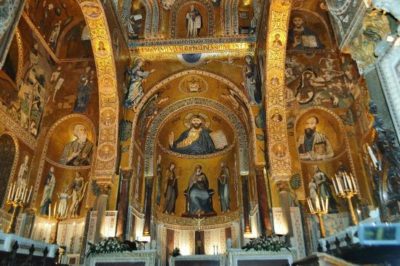
The ancient Palazzo degli Emiri became the center of European culture and art between the twelfth and thirteenth centuries, hosting the greatest scientists and poets, musicians and painters of the time. In 1269 a period of decline began for the palace. Devoid of war machines, he was vulnerable during the revolts of the Sicilian Vespers culminating in 1282: the people of Palermo in revolt took him by plundering him. After the Angevins were driven out, Peter III of Aragon moved into the Palace and resided there for three years. Around 1340 a disastrous collapse gave rise to a series of failures that favored the progressive depopulation of the palace. It was the seat of the Court of the Holy Inquisition between 1513 and 1553 and in the second half of the sixteenth century it returned to play a leading role with the Spanish viceroys who elected it as their residence. In the Bourbon period the royal apartments underwent a remodulation and in 1735, with Charles III of Bourbon, the monumental Scala Rossa was built near the colonnaded courtyard of the Duke of Maqueda. Ferdinand III also had the palace restored, which housed the sovereigns, who had fled from Naples under the control of Napoleon Bonaparte. On the occasion of the revolutionary uprisings of 1848 the tumultuous people demolished the bastions of Santa Maria and San Michele, the dwelling was again sacked. After the unification of Italy, it became part of the assets of the command of the Army Corps and, on the occasion of the national exhibition of 1891 – 1892, the furnishings of the royal apartments were renewed. In 1921 the government bought the property and in the 1930s restorations were carried out which brought to light some Norman structures. In 1943 it was requisitioned by the allied troops. Shortly after the end of the second world war in 1946, the first archaeological essays began to understand the stratifications of artifacts and settlements prior to the Arab interventions. In 1947 it was called Palazzo dei Normanni and became the seat of the Sicilian Regional Assembly. The Royal Palace has many styles: Romanesque, Byzantine, Arabic, Norman, Neo-Gothic, Chiaramonte, Renaissance, Baroque. Among the internal courtyards, two are equipped with loggias and porticos: the Cortile Maqueda, entirely porticoed with two orders of Renaissance-style loggias, and the Cortile della Fontana, placed at a higher level than the first. Below the patio level there are the Sale of the Duke of Montalto, now locations for exhibitions and displays, which in turn are accessed through underground excavations.
Castle of Cuba, Palermo: built by William II in 1180, the great pavilion where the king stayed during the day is one of the last perfectly preserved Norman architecture. The single-storey building has a rectangular shape and is approximately 31 meters long and 17 meters wide. Four tower-shaped bodies protrude at the center of each side. Originally surrounded by an artificial lake and connected to the shore only by a strip of land, today the building is instead entirely surrounded by a courtyard that has taken the place of the dried up pond. Over the course of time the structure has suffered severe collapses and alterations but since the fifties it became the property of the Sicilian Region that in the eighties and nineties has implemented a massive restoration and enhancement of the building so that today the Cuba is one of the most beautiful and important monuments of the city. Noteworthy in Palermo are the Castle of Maredolce, the Castle at sea, the Tower of Fra Giovanni or Torre del Rotolo and the sixteenth-century Torre di Garbonogara.
Torre della Mandre, Altavilla Milicia: known even more simply as the Norman Tower, it was built to meet the needs of defense against attacks by pirates and Maghreb pirates. The structure, in excellent architectural condition, is now privately owned and is together with the other two city towers (Torre della Milicia and Torre Colonna), symbol of the municipality.
Villa Cattolica, Bagheria: completed in 1736 at the behest of Francesco Bonanno, prince of Cattolica, is a quadrangular castle with a central cruciform court surrounded by low buildings and surrounded by green and high crenellated walls. The building was purchased by the city administration in 1988 and restored between 1995 and 1998. It currently houses the Renato Guttuso Museum where in addition to the works donated by Guttuso to the city are preserved works by Onofrio Tomaselli, Silvestre Cuffaro, Domenico Quattrociocchi, Pina Calì, Vincenzo Gennaro and Giuseppe Pellitteri. We also point out in Bagheria the Palazzo Aragona Cutò built between 1714 and 1716 by the will of Prince Luigi Onofrio Naselli of Aragon and the countless towers of the city: Torre Amalfitano, Torre Bellacera, Torre Chiarandà, Torre Ferrante, Torre Mortillaro and Torre Roccaforte.
Norman Castle of Caccamo, Caccamo: it is one of the largest and best preserved Norman castles in Sicily and in Italy. The manor stands on top of Monte San Calogero (521 meters above sea level) and overlooks the surrounding countryside. Originally the site, thanks to its strategic position, was probably occupied by a fortress or watch tower of Arab origin. The Norman style structures are conferred by Matteo Bonello, lord of Caccamo, in the twelfth century following the reconquest of the island. The most important room inside is the Hall of Conspiracy: in this environment, in 1160, some Norman barons ordered the plot against the sovereign William I of Sicily. In October 1963 the house was purchased by the Sicily Region began restoration work in 1974. The ancient castle is today the evocative setting of the traditional town event entitled “La Castellana”. To be pointed out again in Caccamo the numerous sighting towers three which the Torre Pizzarone and the Tower of the Bells.
Campofelice di Roccella Castle, Campofelice di Roccella: situated along the beach on a rocky outcrop, the Castle was probably built by the Arabs on the remains of an ancient tower. The king of Sicily Roger II then transformed it into a strategic military outpost and in 1485 was granted to Gaspare Spes, count of Sclafani. Today of the Castle you can admire some remains on the beach: arched windows with a double center and a chapel.
Castle-fortress of Carini, Carini: it was built between the end of the XI and the beginning of the XII century by the first Norman feudal lord Rodolfo Bonello, warrior of Count Ruggero. The Castle rests the foundations on a pre-existing construction, certainly of the Arab era. In 1283, and for about a century, it became property of the Abate family who modified its defensive structure to residential. In 1397 it became the property of Ubertino La Grua and, at the end of the 15th century, restoration work was carried out. Beyond the walls, you reach a large courtyard and admire the internal façade, a mixture of various architectural styles. Legend has it that in 1563 the baroness Laura Lanza di Trabia was killed here, accused of having betrayed her husband Vincenzo II La Grua.
Castello dei Ventimiglia, Castelbuono: the original nucleus of Castelbuono, is composed of a large cubic mass and four quadrangular towers. The imposing structure, built on the model of the Aragonese male, underwent numerous subsidence in the earthquake of 1919, including the collapse of the Ghibelline battlements of the façade, emblem of the origins of the family.
Castle of the Duke of Salaparuta, Casteldaccia: built around 1400, it is the oldest monument in the municipal territory. Built in order to defend the local population, the Castle over time was owned by several Sicilian noble families. In 2000 the building was purchased and restored by the Municipality of Casteldaccia. We also point out the Tower of Chiarandà in Casteldaccia.
Diana Castle, Cefalà Diana: probably built around the mid-fourteenth century as a defensive bulwark, over the years it became a grain store and then a noble residence.
Cefalù Castle, Cefalù: of uncertain historical date, the building, with a rectangular plan and surrounded by a wall rises on top of the fortress overlooking the city. Used throughout the fourteenth and fifteenth centuries, the castle underwent extensive alterations between the sixteenth and seventeenth centuries and then was abandoned. Since 1989, major works of geological consolidation, restoration and archaeological excavations have been started.
Towers of Cinisi, Cinisi: located along the coast, the watch towers built with defensive purposes between the fourteenth and seventeenth centuries are the true symbol of the city. The most famous are Torre Molinazzo, Torre Pozzillo and Torre dell’Orsa, ancient site of a tuna fishery managed by the Benedictines.
Saracen Tower of Castello Soprano, Corleone: it is the only still visible part of the Soprano Castle of medieval origin. Of the Castello Sottano, also from the Middle Ages, there remain only a few ruins incorporated into a residential complex built in later periods. We also point out in the hamlet of Ficuzza the Real Casina di Caccia built starting in 1799 by King Ferdinand III of Sicily.
Castello di Ficarazzi, Ficarazzi: witness of the historical and social events of the town, the villa of the princes Giardina is the symbol of the town. The building was born in the fifteenth century as a defensive tower and home of its builder, Pietro Speciale. During the eighteenth century the Giardina family transformed it into a sumptuous holiday residence enriched by decors, large halls and balconies with characteristic pot-bellied railings, over the imposing entrance staircase.
Castle of Geraci, Geraci: built in the Byzantine age, it was modified by the Normans to adapt it to their defensive needs. The ancient manor, in fact, thanks to its inaccessible position and its military structure, was the first western defense of the vast county. The Castle was suitable to resist even long assaults: in the subsoil there were water cisterns, storage areas and prisons, while the upper floor was used as the residence of the Count’s family. Unfortunately today only a few ruins remain of the Castle.
Giuliana Castle, Giuliana: made up of an irregular trapezoidal shaped body, it belonged to the Archbishop of Monreale in Norman times and was then restructured for strategic needs under the dominion of the Swabian Federico II. The Castle has recently undergone restoration work.
Towers of Isola delle Femmine, Isola delle Femmine: these are the historical and architectural symbol of Isola delle Femmine. Their specular position refers to the strong connection between the islet and the mainland as parts of a single community. The Tower of the Sea, with a quadrangular plan, is located on the hill overlooking the small island and was built at the end of the sixteenth century as a strategic outpost in defense of the coasts. The circular Tower of Earth, also known as the Torre del Senato of Palermo, was built in the 12th century to defend the ancient tuna fishery.
Castello Beccadelli Bologna, Marineo: the symbolic monument of Marineo is without a doubt the noble tower, called Castello Beccadelli Bologna from the name of its historical founder. In fact, the country developed around its mighty structure. The Castle now houses the Regional Archaeological Museum of the Eleuterio Valley.
Misilmeri Castle, Misilmeri: also known as the “Castle of the Emir”, it consisted of a polygonal tower surrounded by a wall. Erected by the Arabs and then passed into the hands of foreign rulers who succeeded to lead the town, underwent some substantial changes around 1340, when the Chiaramonte family built a further circle of walls and the chapel, which was dedicated to Sant ‘Antonio. In the nineteenth century, with the abolition of feudalism, the structure remained without owners and since then began the slow and progressive abandonment that led the building to a state of ruin.
Castellaccio, Monreale: located on the top of Monte Caputo, it is a fortified monastery built by the Normans in the 12th century. The building, also known as the Castle of San Benedetto, underwent numerous devastations over the centuries and was restored in 1898 by the architect Giuseppe Matricolo.
Torre Ventimiglia, Montelepre: the fifteenth-century feudal tower is the heart of today’s city. The building, in the form of a parallelepiped, originally formed a large court incorporating the dense array of rural houses built in the shelter of its walls.
Bourbon Castle, Palazzo Adrano: located on the hill of San Nicola, the castle dates back to the eighteenth century and was built around a keep of the Federician period around which developed the oldest part of the country. The few remaining ruins of the ancient Castle have recently been restored.
Ventimiglia Castle, Pollina: between architectures of historical-architectural interest of the municipality of Pollina there is the Norman Castle of Ventimiglia of which only one tower is visible called Torre del Marchese.
Solanto Castle, Santa Flavia: built in the twelfth century, it was the residence of King Roger. After complete abandonment, which lasted centuries, the building was restored during the twentieth century with the annexation of a building in neo-gothic style, summer residence of the princes of San Vincenzo.
Palazzo La Grua, Terrasini: the feudal past of Terrasini relives in the architecture of the historic buildings that enrich its center from Palazzo La Grua, an eighteenth-century castle that now houses the Municipality. We again report to Terrasini Torre Alba, also known as Torre di Cala Rossa, a coastal defense tower that was part of the Coastal Towers system of Sicily.
Castello Lanza, Trabia: also known as the ancient fortress of Trabia, is the symbol of the city. The Castle, surrounded by a square-shaped walls, has a circular tower in the central courtyard, once used as a prison and lateral turrets equipped with artillery. We also point out the Castle of San Nicola in the territory of the municipality.
Towers of Ustica, Ustica: they were built by the Bourbons to defend the village. Both part of the Coastal Towers of Sicily, Torre di Santa Maria and Torre dello Spalmatore are today a symbol of the city.
Castello di Vicari, Vicari: the ruins of the Castle, built by the Chiaramonte family in the 14th century on the original Norman structure, are located in a valuable medieval center.
Castello di Collesano, Collesano: The Castle of Collesano was built during the Norman domination by the Countess Adelasia, around the first decades of the 1100s, when King Roger II had the site destroyed on the Monte d’Oro due to conflicts with his brother-in-law Rainolf. From the 13th century the castle passed into the hands of the Cicalas of Alife. With the Angioinians it reaches the De Monforts, and then Giovanni de Bullasio. At the birth of the new County of Collesano, following the Sicilian Vespers, for almost all of the ‘300, the Castle and the land will be in the hands of Francesco and Antonio Ventimiglia. In the ‘400, after Antonio Centelles, the whole county passed to the Cardona and subsequently to the Moncada up to the entire 1600s. In this period, one of the largest rooms is transformed into a theater for performances staged by the Academy of the Blurred. The earthquake of 1693 rendered the Castle unusable. Subsequently the Castle will be in possession of the Dukes of Ferrandina in the ‘700 and of the Alvarez de Toledo in the 800. Only the ruins of the castle remain visible today.
